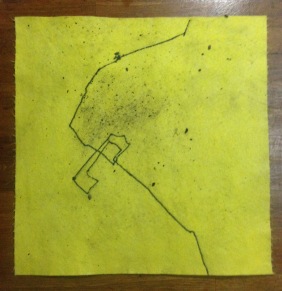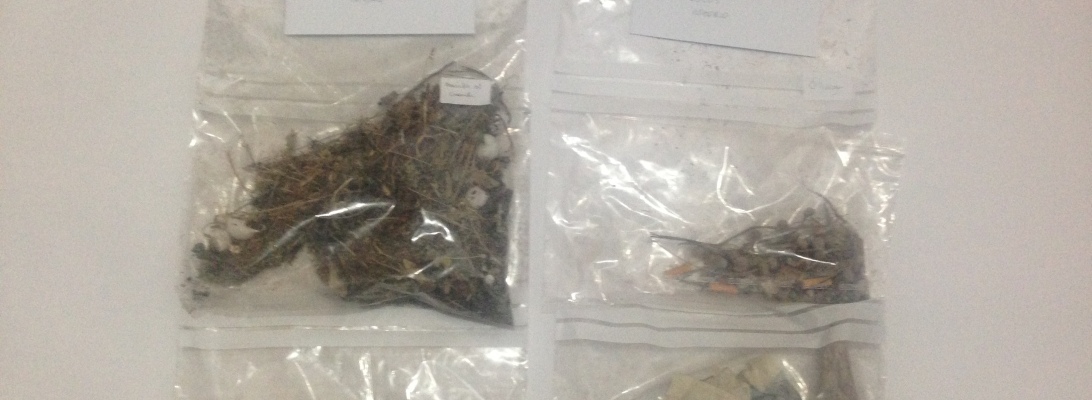Today I went to just 2 places but that means I have finished the performances in Spain except for, ironically, Madrid. I am leaving Madrid until last as I want to record it as it will be easier to get someone to film. This week has been exhausting and also a huge learning curve. It was far more useful doing just 2 in a day. I could take my time, choose my places pretty well and experiment more. Being the Saturday of the easter weekend also meant there were more people around and that was good for me.
Atienza…
is a medieval town with a population of less than 500 but on the easter weekend there were quite a few visitors and their three very small museums were open. I had looked on google maps as usual and had found this square where I thought there would be space to clean and there was also a church which is a museum in front and a fountain. In fact it was the most comfortable place to work I have found so far because there were also tables. Before starting this project I really hadn’t thought so much about all the logistics of just having the appropriate equipment and being focused when nervous.
Being more comfortable to work made things a lot easier and allowed me to experiment more with some of the things I don’t think work so well. The original idea had been to find lines as well as making drawings through the act of cleaning. In the North of Spain I had mainly focused on the latter.
Here I felt I had time to look for lines and try to make them using water, scrubbing brush and dirt. The square seemed to be full of them, I also drew line drawings on that section of the map with Atienza on it. Quite a few people passed by whilst I was there. Only one person spoke to me, but that was a first, she asked me for directions, probably thinking I lived there as I was sweeping at that point. A real variety of age groups passed by, some wandered around the square, others passed along the road. There were quite a few families and children but none of them spoke to me or asked what I was doing. I realized that in a way that was disappointing. I started to fantasize that they didn’t approve of my ‘playing’ with the dirt but that might be my imagination. A lot of children were fascinated with the tadpoles in the fountain which was fair enough. When I left I felt a bit disappointed that no one had interacted verbally but then, neither had I. Nevertheless I was more satisfied with how the drawing had gone and it felt like I had started to link the cleaning and drawing more.
Whilst driving through Guadalajara I was thinking about my whole insistence on the line. I was trying to define it. I had originally thought of lines as traces. The line to Barnsley tracing my journey. I had also considered the political nature of making the maps, the lines that trace the borders and how they have changed. At the moment we cross the border into France in the same way as we change region in Spain or County in England but in the past this has been strongly contested as is the Basque border and I was reminded of this whilst driving through Navarra earlier in the week. But a line does not have to divide and separate, I wanted the road to link to show the commonalities of all these places. Of course I will be reminded on the way of the differences.
The Village of Padilla de Hita is probably normally deserted, according to wikipedia there were 21 people registered as living there in 2014. Usually, but exclusively, these tend to be older people. However, as it was easter lots of families were there visiting so I saw quite a few people whilst there. This time I took my long broom and dust pan partly as props as well as brushing standing up to begin with.
A small boy immediately asked me what I was doing and whether I was cleaning. I told him yes I was cleaning but also drawing too. He and his father played football for a while whilst I was working. A few other people passed through and others came to their doors. I now feel I need to have some kind of a uniform or develop the performative element in some way to engage people. The route through Spain has been relatively small places and at the beginning I shied away from the busiest places. However, even where there were people today I was not convinced that the action was so clear.
Physically what is starting to come together is a pile of cloths, bags of dirt, lists, drawings on maps and hopefully more dirt in the mail. There are also photographs and a video (from London). This is leading me to reflect on the relationship between the technologies. I feel so strongly about my need to create hand made work. Partly because I am better at it and also because I feel I need that contact with materials. However there is also the other point about the importance of making things and the need to conserve old technologies alongside the new. I have decided not to use photos or videos in the exhibition but I will use them on social media. (written 15th April 17).





 awing a map over the dirt I collected in Ólvega, Soria because I won’t be using this place as part of the final line. I already have an imbalance of places in Spain compared to France and UK. I took the dirt from Ólvega and drew the map of my journey through the town using permanent marker. Without moving the cloth much I then covered the whole thing with diluted pva and it seems pretty stable, ie the dirt doesn’t fall off anymore. Of course the cloth is also now harder and more rigid but I am not sure it matters although I did like the feel of the cloth.
awing a map over the dirt I collected in Ólvega, Soria because I won’t be using this place as part of the final line. I already have an imbalance of places in Spain compared to France and UK. I took the dirt from Ólvega and drew the map of my journey through the town using permanent marker. Without moving the cloth much I then covered the whole thing with diluted pva and it seems pretty stable, ie the dirt doesn’t fall off anymore. Of course the cloth is also now harder and more rigid but I am not sure it matters although I did like the feel of the cloth.













 Another interference in my process is that I keep getting ideas which become about using the dirt to in some way represent the cleaners. Yet when talking to Emily Speed in February she asked me whether the drawing needed to be figurative I said no automatically and immediately. It was obvious from the beginning that I was not talking about representation. However recently I have been making very representational work. I am maybe concerned that my final exhibition for the MA is not consistent with what I have been working on over the past 2 and half years. Even at the beginning of the year I was going to make work about the history of Barnsley and I was interested in the legacy of the miners wives for instance. The history of the Trades Unions was also compelling for me. However, I did not see how I could do it justice in such a short time. The exhibition in Madrid about the history of work in one area has taken years of work and research on and off.
Another interference in my process is that I keep getting ideas which become about using the dirt to in some way represent the cleaners. Yet when talking to Emily Speed in February she asked me whether the drawing needed to be figurative I said no automatically and immediately. It was obvious from the beginning that I was not talking about representation. However recently I have been making very representational work. I am maybe concerned that my final exhibition for the MA is not consistent with what I have been working on over the past 2 and half years. Even at the beginning of the year I was going to make work about the history of Barnsley and I was interested in the legacy of the miners wives for instance. The history of the Trades Unions was also compelling for me. However, I did not see how I could do it justice in such a short time. The exhibition in Madrid about the history of work in one area has taken years of work and research on and off.